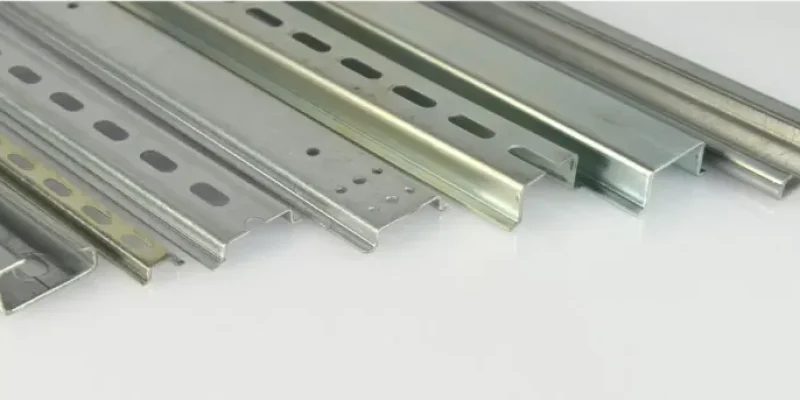DIN rail is a standardized metal mounting rail used extensively in industrial control panels, electrical enclosures, and automation systems worldwide. Originally developed by the German Institute for Standardization (Deutsches Institut für Normung, or DIN), these rails have become the global standard for mounting a wide variety of electrical components. If you’ve ever looked inside an electrical panel or industrial control cabinet, you’ve likely seen DIN rails in action—they’re the backbone of organized electrical installations across numerous industries.
Understanding DIN Rail: Definition and Origins
What is DIN rail exactly? At its core, a DIN rail is a standardized metal strip that serves as a universal mounting platform for electrical and industrial components. This simple yet ingenious solution allows for quick installation, easy reconfiguration, and efficient use of space in electrical enclosures. The rails themselves are most commonly manufactured from cold-rolled carbon steel sheets, which are then subjected to surface treatments such as zinc plating or chromating to provide robust protection against rust and corrosion.

The History and Development of DIN Standards
The acronym “DIN” stands for “Deutsches Institut für Normung,” which translates from German as the German Institute for Standardization. This institution was originally responsible for establishing and defining the industrial specifications for these versatile mounting rails.
The concept of the DIN rail has its roots in Germany, with its first introduction dating back to the early 20th century. Some accounts suggest the system was initially devised in the late 1920s. The primary objective behind its development was to standardize the mounting of industrial electrical components, particularly electrical control devices and terminal blocks.
In the 1920s, the Deutsches Institut für Normung (DIN) began the formal process of developing standards for industrial components, including electrical devices. The DIN rail was formally standardized under designations like DIN 46277-1. While initially a German standard, the inherent practicality and efficiency of the DIN rail system led to its widespread adoption internationally. The system gained broader acceptance and was further developed into its current common forms during the 1950s, first spreading through neighboring European countries and then rapidly being taken up worldwide.
Why DIN Rails Became Industry Standard
DIN rails quickly gained popularity for several compelling reasons:
- Universality: Components from different manufacturers could be mounted on the same rail
- Simplicity: The snap-on design eliminated the need for complex mounting hardware
- Efficiency: Rails allowed for dense component placement without sacrificing organization
- Flexibility: Systems could be easily modified or expanded as needs changed
Today, DIN rails have transcended their European origins to become the de facto global standard for industrial electrical mounting solutions.
Types of DIN Rails and Their Specifications
Not all DIN rails are created equal. The industry recognizes several standard profiles, each designed for specific applications and component types. These profiles are governed by international standards, primarily IEC/EN 60715, which specifies the critical dimensions and manufacturing tolerances.
Top Hat (TS35 / TH35) DIN Rail
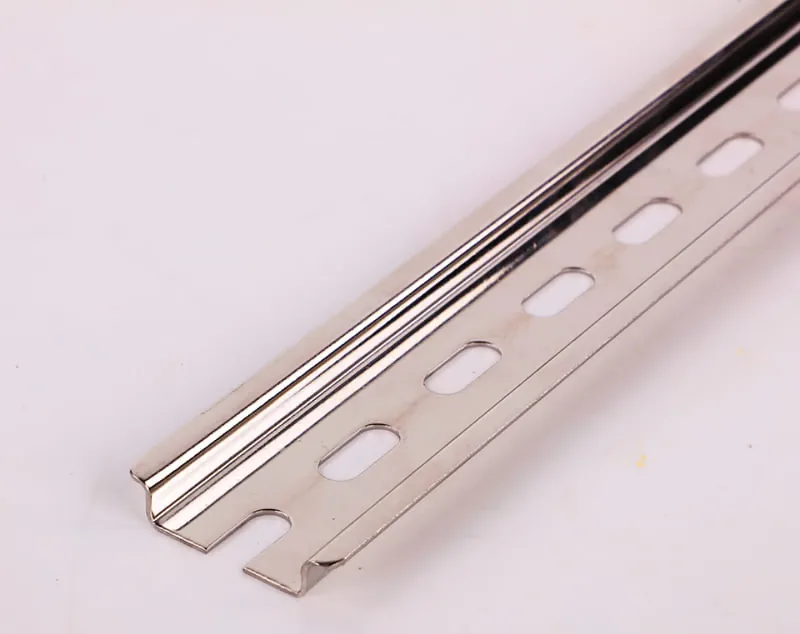
The TS35 rail (35mm width) is by far the most widely used type in industrial and commercial applications, accounting for approximately 80% of all DIN rail installations worldwide. Often called “top hat” rail due to its distinctive profile, it comes in two standard depths:
- 7.5mm depth: The standard option for most general applications, formally designated under IEC/EN 60715 as “35 × 7.5”
- 15mm depth: A deeper version for heavier components or higher vibration environments, formally designated as “35 × 15”
Due to its shape, it is also sometimes referred to as Type O or Type Omega (Ω). In the United States, it is commonly known as the TS35 rail.
C-Section (TS32) DIN Rail
The TS32 (32mm width) C-section rail was one of the earliest DIN rail designs. It is characterized by its C-shaped cross-section and is associated with standards like EN 50024, although this standard is now often noted as abrogated. While less common in new installations, you’ll still find it in:
- Legacy systems and older European installations
- Specialized applications requiring its unique mounting profile
- Certain telecommunications equipment mounting scenarios
C-section rails may be encountered in older electrical installations or used for specific legacy equipment. Due to their profile offering good wall support, they have been used for heavier items such as power supplies and transformers. However, mounting modern components onto C-section rails often requires the use of an adapter.
G-Section (TS15) DIN Rail
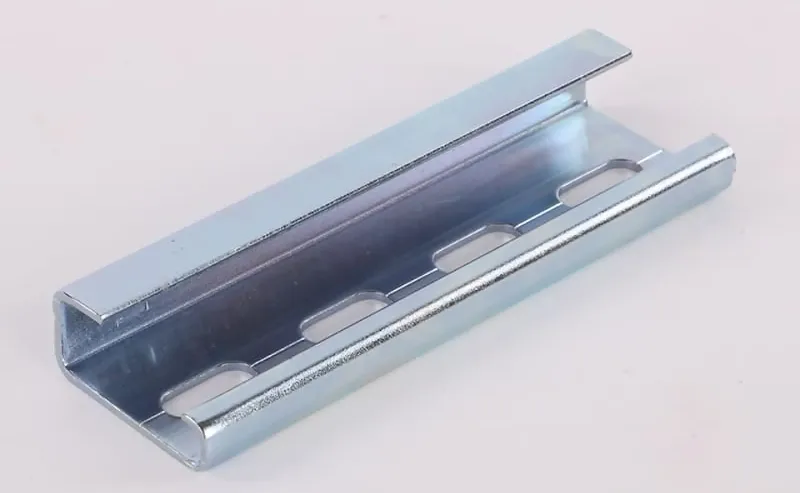
The smallest standardized profile is the TS15 (15mm width) G-section rail. G-Section DIN rails, also known as G32 or sometimes TS32 (though this can cause confusion with C-section TS32), feature a distinctive G-shaped (or sometimes J-type) cross-section. This profile often includes a deeper recess on one side than the other.
G-section rails are associated with standards such as EN 50035 (which some sources note as abrogated), BS 5825, and the original DIN 46277-1. This miniaturized rail is primarily used in:
- Space-constrained applications
- Lightweight component mounting
- Specialized electronics enclosures
These rails are specifically chosen for applications where strong support and precise alignment are critical, particularly for heavy machinery, large power supplies, transformers, or other substantial components that may be subjected to high dynamic forces or vibration. The asymmetrical design of the G-section rail can also help to prevent incorrect installation of components.
DIN Rail Dimensions and Material Options
Standard DIN rails are typically manufactured from:
- Galvanized steel: Most common, offering good corrosion resistance at an economical price. These are typically cold-rolled carbon steel sheets that undergo electrolytic plating with zinc, which is often followed by a chromate passivation process (resulting in a clear or sometimes yellowish finish).
- Stainless steel: For harsh environments, food processing, or outdoor applications. These rails are typically made from high-grade stainless steel, such as AISI Type 304 (also known as V2A stainless steel), which is highly resistant to corrosion and exceptionally durable.
- Aluminum: When weight reduction is critical or for specific electrical grounding requirements. Aluminum rails are significantly lighter than their steel counterparts and possess good inherent corrosion resistance due to the natural formation of a protective aluminum oxide layer on their surface.
Rails come in various lengths, typically available in 1-meter, 2-meter, and custom-cut options. The standard thickness ranges from 1mm to 2.3mm depending on the application requirements.
DIN rails are also available in two primary configurations:
- Solid (unperforated): Offering greater inherent rigidity and mechanical strength, preferred for applications subjected to significant vibration or where robust support is required for particularly heavy components.
- Slotted (perforated): Featuring a series of pre-machined holes or elongated slots that provide increased flexibility for mounting and can facilitate easier wiring and cable management.
DIN Rails in Action: A Spectrum of Applications Across Industries
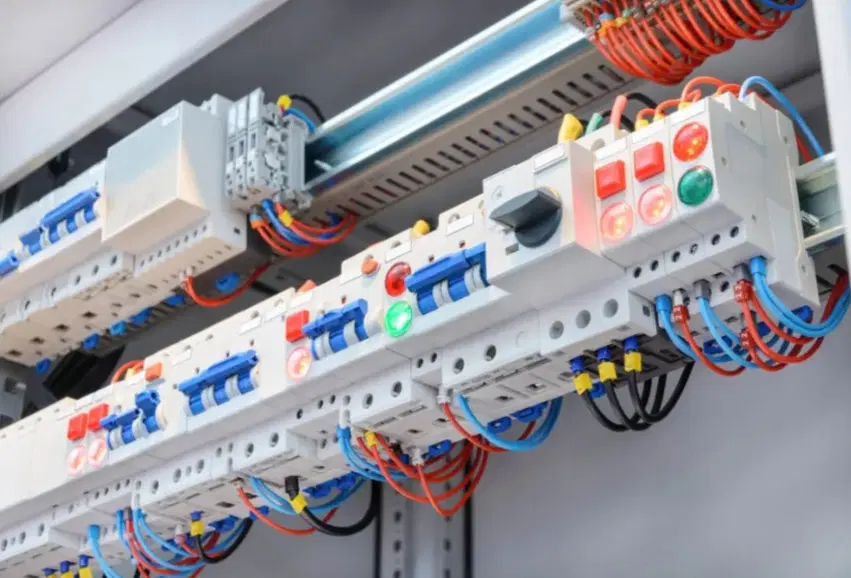
The versatility, standardization, and efficiency of DIN rail systems have led to their widespread adoption across a remarkably diverse spectrum of industries and applications. From heavy industrial manufacturing to sophisticated building automation and emerging renewable energy technologies, DIN rails provide a common backbone for organizing and mounting critical electrical and electronic components.
Industrial Automation and Manufacturing Control Panels
This is a core and traditional application area for DIN rails. They are used extensively within control cabinets and panels that govern machinery, manufacturing lines, and entire process control systems. Common components mounted include Programmable Logic Controllers (PLCs), their associated input/output (I/O) modules, motor controllers (such as VFDs and soft starters), relays, contactors, various sensors, interface modules, and power supplies. DIN rails facilitate the creation of organized, high-density, and easily serviceable layouts, which are essential for the complexity and reliability demands of modern automation systems. They are fundamental to Motor Control Centers (MCCs), process control panels, and machine safety systems.
Energy Management, Distribution, and Renewable Energy Systems
In the energy sector, DIN rails are indispensable for power distribution panels, where they mount circuit breakers (MCBs, MCCBs), energy meters, current transformers, and terminal distribution blocks. They are also crucial components in substation control cabinets for housing protection relays and control equipment. A significant and growing application area is in renewable energy systems. For solar power installations, DIN rails are used to mount photovoltaic (PV) inverters, charge controllers, battery management systems (BMS), string monitoring devices, and DC disconnects. Similarly, in wind power systems, they support control and monitoring components.
Intelligent Buildings: HVAC, Lighting, and Security Controls
DIN rails are widely employed in modern building automation and management systems (BMS). They provide the mounting infrastructure for controllers, relays, timers, sensors, and interface modules that manage Heating, Ventilation, and Air Conditioning (HVAC) systems, lighting controls (including dimmers and scheduling units), and security systems (such as access control and alarm panels). The modularity offered by DIN rails allows for flexible and scalable building control solutions.
Telecommunications Infrastructure and Data Centers
Within telecommunications infrastructure and data centers, DIN rails are used in network equipment racks, communication hubs, and distribution frames. They mount components such as patch panels, fiber optic termination boxes and modules, small industrial-grade network switches, media converters, and compact power supplies. Miniature DIN rails (TS15) are particularly advantageous in these applications due to often severe space constraints within telecom cabinets and enclosures.
Transportation Systems (Rail, Marine, Automotive)
The transportation sector also leverages DIN rail systems. They are found in railway signaling systems, on-board train control cabinets, and traffic control systems. In marine applications, DIN rails are used in electrical panels for navigation, communication, and control systems, where materials like stainless steel or aluminum are often chosen for their enhanced corrosion resistance in saltwater environments. They are also increasingly seen in electric vehicle (EV) charging infrastructure for mounting control electronics and protective devices.
Residential Electrical Installations
While traditionally more common in industrial and commercial settings, DIN rails are increasingly being used in modern residential electrical distribution boards (consumer units). They provide a neat and standardized way to mount Miniature Circuit Breakers (MCBs), Residual Current Devices (RCDs), Residual Current Breakers with Overcurrent protection (RCBOs), surge protection devices, and sometimes smart home modules. The TS35 rail, typically the 7.5mm depth version made from zinc-plated steel, is common in these applications due to its space efficiency, broad component compatibility, and cost-effectiveness.
The DIN Rail Ecosystem: Mounted Devices and Essential Accessories
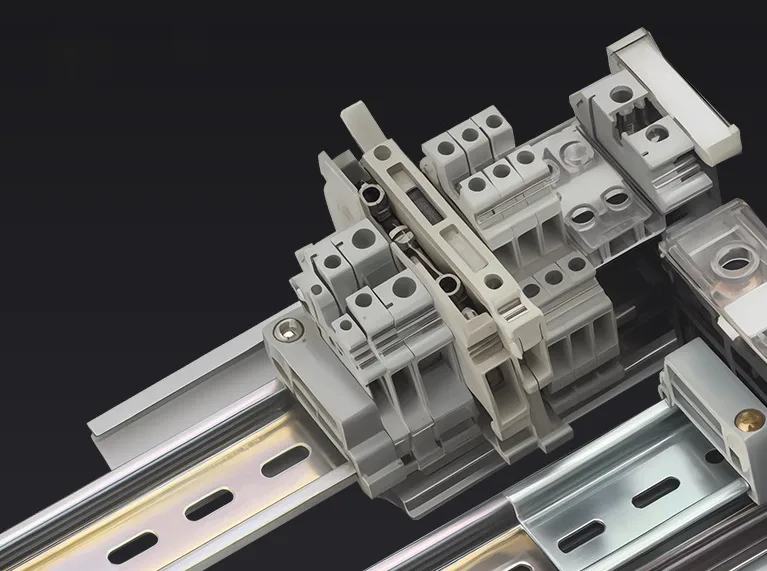
A comprehensive range of accessories is crucial for completing a functional, safe, and well-organized DIN rail assembly. These accessories enhance the system’s capabilities and ease of use. Key accessories include:
End Brackets / End Clamps / Stoppers
These are vital for securing components on the DIN rail and preventing any lateral movement or dislodgment, especially in environments subject to vibration or during transportation. They are typically placed at both ends of a row of mounted devices. Examples include the Phoenix Contact CLIPFIX 35-5 and E/NS 35 N end brackets.
End Caps / Separators / Partition Plates
End caps are used to cover the exposed conductive sides of certain types of terminal blocks, enhancing safety. Separator or partition plates are used to physically and electrically isolate different groups of components or terminal blocks, for instance, to separate circuits of different voltages or functions.
Jumpers / Bridges (Fixed or Insulated)
These are used to electrically connect adjacent terminals within a terminal block assembly, creating common potentials for power distribution or signal commoning. They provide a more reliable and neater connection than using individual wires for short links.
Marking Systems / Labels / Tags
Clear and consistent labeling is essential for identifying components, terminal blocks, individual terminals, and associated wiring. This greatly aids in installation, commissioning, troubleshooting, and maintenance. Marking systems can include adhesive labels, snap-on plastic markers, printable marker strips, or engraved plates. Labels may indicate device numbers, voltage/current ratings, functions, or safety warnings.
Support Brackets / Standoffs
These can be used to provide additional support for the DIN rail itself, especially for longer spans or when mounting particularly heavy components. They can also be used to elevate the DIN rail from the mounting surface to create more space for wiring or deeper components. The STS series of DIN rail support brackets is one example.
DIN Rail Installation Best Practices
Proper installation ensures the reliability and longevity of DIN rail systems.
Tools and Materials Required for DIN Rail Installation
Basic DIN rail installation typically requires:
- Metal cutting tools (for custom lengths) – specialized DIN rail cutters are highly recommended as they provide clean, square, burr-free cuts
- Measuring tools including a spirit level to ensure the rail is mounted straight
- Drilling equipment and appropriate fasteners
- End stop installation tools
- Component marking implements
More specialized tools might be needed for specific rail types or mounting environments.
Step-by-Step Installation Process
A proper DIN rail installation follows these general steps:
- Measure and plan the layout, ensuring adequate space for all components
- Cut the rail to the required length if necessary
- Mount the rail securely to the panel or enclosure, ensuring it is perfectly level and straight
- Install end stops at appropriate locations
- Snap components onto the rail in the planned configuration
- Connect wiring according to the system design
- Label components and wiring for future reference
Following this systematic approach ensures a clean, professional installation.
Common Installation Mistakes to Avoid
Even experienced installers sometimes make these errors:
- Insufficient spacing between components, leading to heat issues
- Inadequate rail securing, resulting in movement and potential failures
- Mixing incompatible components with different rail type requirements
- Poor planning for future expansion
- Inadequate labeling, creating maintenance difficulties
- Misalignment of rails, which can make it difficult to snap components on or off
- Overloading rails beyond their specified weight limits
Avoiding these pitfalls leads to more reliable and maintainable installations.
Advantages of Using DIN Rail Mounting Systems
The widespread adoption of DIN rail technology stems from its numerous practical benefits.
Space Efficiency and Organization Benefits
DIN rail mounting provides:
- Maximum utilization of panel space
- Logical component grouping and organization
- Standardized spacing for optimal cooling
- Clean, professional appearance
These attributes are particularly valuable in space-constrained applications.
Flexibility and Scalability Advantages
DIN rail systems excel at adaptation:
- Components can be easily added, removed, or relocated
- Systems can grow incrementally as needs expand
- Technologies can be upgraded without complete reinstallation
- Standardization allows integration of components from multiple vendors
This flexibility reduces total lifecycle costs for industrial and commercial systems.
Maintenance and Replacement Simplicity
When service is required, DIN rail mounting shines:
- Faulty components can be replaced without disturbing adjacent devices
- Systems can be partially upgraded without complete replacement
- Troubleshooting is simplified through organized layout
- Standardized components reduce spare parts inventory requirements
These maintenance advantages translate directly to reduced downtime and lower service costs.
Selecting the Right DIN Rail for Your Application
Choosing the appropriate DIN rail involves several important considerations.
Key Factors to Consider When Choosing DIN Rails
Decision factors include:
- Component compatibility: Ensure all devices support your chosen rail type
- Load requirements: Consider the weight and number of components
- Environmental conditions: Temperature, humidity, corrosion risk, and vibration
- Regulatory compliance: Industry-specific standards and requirements
- Installation constraints: Available space and mounting options
- Material selection: Choose appropriate material (steel, aluminum, stainless steel) based on the application environment
- Rail configuration: Determine if solid (unperforated) or slotted (perforated) rails are more suitable for your specific needs
Balancing these factors leads to optimal system performance and reliability.
Industry-Specific Requirements
Different sectors have unique DIN rail considerations:
- Food and beverage: Stainless steel rails for sanitation requirements and resistance to cleaning agents
- Transportation: High-vibration tolerant mounting systems, often requiring solid rails for maximum rigidity
- Hazardous locations: Specialized grounding and material requirements
- Outdoor installations: Corrosion-resistant materials and weatherproofing
- Marine environments: Stainless steel or aluminum rails for enhanced corrosion resistance in saltwater environments
- Weight-sensitive applications: Aluminum rails for transportation equipment (rail, aerospace, automotive)
Understanding these specialized needs ensures appropriate rail selection.
Future-Proofing Your DIN Rail Installation
Planning for tomorrow’s needs includes:
- Allowing extra rail space for future expansion
- Considering emerging component technologies
- Implementing modular design principles
- Documenting installation details thoroughly
- Selecting rails that support the widest range of components
These forward-thinking approaches extend the useful life of DIN rail installations.
DIN RAIL MANUFACTURING VIDEO
Conclusion: The Enduring Value of DIN Rails in Modern Electrical Systems
The DIN rail technology represents one of the most successful standardization efforts in industrial history. What began as a German initiative in the early 20th century has evolved into a global standard that transcends industries, applications, and technologies. Its journey from a national specification to a cornerstone of international electrical practice underscores the power of a well-conceived, practical, and standardized solution to address universal engineering challenges.
The enduring success of the DIN rail system can be attributed to a confluence of key advantages. Its primary contribution is the standardization it brings, ensuring interoperability between components from countless manufacturers worldwide. This leads to versatility in component choice and flexibility in system design and modification. The system promotes highly organized installations, leading to significant space efficiency within panels and a reduction in clutter. This organization, coupled with the ease of snapping components onto the rail, translates into substantial time and cost savings during installation and commissioning.
Despite its apparent simplicity—a mere strip of metal—the DIN rail is a cornerstone of modern electrical panel building and industrial automation design. Its critical role stems from its ability to simplify complexity, foster modularity, and enhance efficiency across a wide range of applications, from intricate manufacturing control systems to intelligent building management and renewable energy installations.
The DIN rail system’s adaptability to new technologies, such as the integration of IoT-enabled devices, and its suitability for diverse industries highlight its dynamic nature and ensure its continued relevance in an ever-evolving technological landscape. The ongoing evolution in materials, manufacturing techniques, and the standards themselves further points to a system that is responsive to new challenges and opportunities.
Understanding what DIN rail is and how to properly implement it is essential knowledge for anyone working with industrial controls, electrical systems, or automation technology. Whether you’re designing a new installation or maintaining an existing one, the humble DIN rail continues to provide the literal backbone upon which modern electrical systems are built.
Related
How To Choose The Right DIN Rails: The Complete Guide
DIN Rail vs. Traditional Mounting
Key Factors Influencing DIN Rail Prices: A Comprehensive Analysis
Top 5 Reasons Why DIN Rails Are Essential in Modern Electrical Installations

